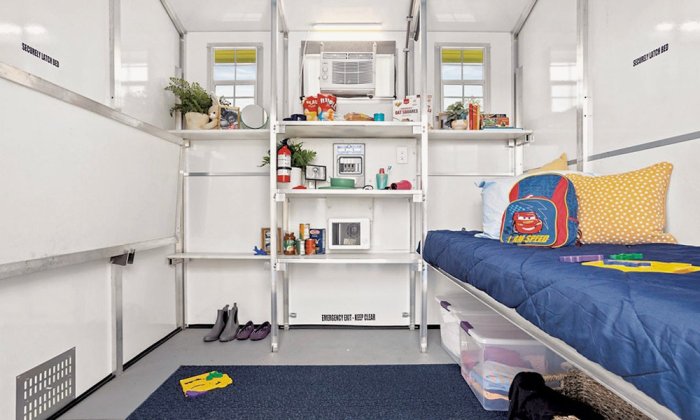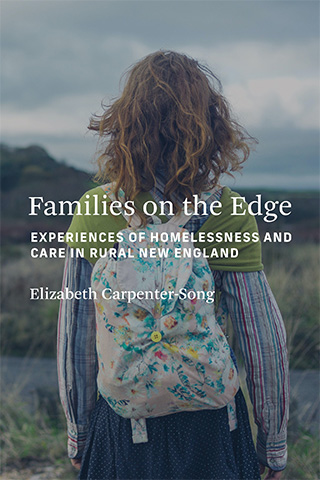The Rhythm of Life at a Homeless Shelter in New England

Research on homelessness in the United States has been overwhelmingly conducted in urban settings, so much less is known about its trajectory in rural areas and small towns. Author and medical anthropologist Elizabeth Carpenter-Song’s new book “Families on the Edge” (available in an open access edition) serves as a corrective to that trend. Her book is an intimate account of rural New England families living on the edge of homelessness, as well as the practices and policies of care that fail them. Drawing on a decade of ethnographic research to chart the struggles of a cohort of families she met in a Vermont family shelter in 2009, Carpenter-Song identifies how specific aspects of rural New England come together to thwart opportunities for families despite their continual striving to “make it” in this environment.
The following excerpt provides a glimpse of everyday life at the Safe Harbor shelter (a pseudonym used throughout the book to protect the privacy of the location), highlighting the tension between individualism and collectivism in supporting homeless families as they strive to find stable housing. All participants gave consent and assent to participate in the study; their names are also pseudonyms.
Arriving at the shelter after dark in the winter, I always saw several cars in the parking lot sending out puffs of exhaust like breath into the chilled air. I came to recognize a rhythm as engines would run for several minutes, fall silent, and then be coaxed again into a low purr. This oscillation was a sign of occupancy: Someone was living in that vehicle and was toggling between a few minutes of warmth and a restless sleep. As I passed such cars, I instinctively averted my gaze from the car windows, preserving what I hoped was a small measure of privacy for its occupant.

I came to know the Safe Harbor shelter through other rhythms — the pull of a smoke break bringing mothers outdoors to congregate at the picnic table; the arrival of shouts and swiftly moving bodies as kids poured out of the school bus, breaking the languid quiet of the afternoon; the steady flow of cars throughout the day as men and women, young and old, came to the food pantry on the first floor of the shelter. Many people were greeted by name, part of a cast of familiar characters around the shelter. Others were obviously new to the process, their eyes anxious and searching, their relief palpable as one of the shelter volunteers invited them to sit for a brief set of questions — “How large is your family? Please mark your income” — before accompanying them down a short hallway to a set of rooms lined with shelves stocked with cans of vegetables, tubs of peanut butter, boxes of cereal and pasta, and bins of fresh fruit.
The khaki clapboard structure and grounds of Safe Harbor, with edible gardens tended by a steadfast corps of volunteers during the short northern growing season, lacked the institutional feel that one might expect of a homeless shelter. The building seamlessly blended into the mix of houses and small businesses that lined the street. Safe Harbor housed up to eight families at a time. Guests (the preferred organizational term for residents of the shelter) occupied the second floor of Safe Harbor, with the space divided into two mirror-image pods housing four families each. Access to the second floor was restricted to shelter staff, resident families, and a limited set of others, such as doctors giving health presentations. I fell into this category of approved others and was granted full access by the executive director to spend time with families in the pods.
I found the ethos of the organization to be individualistic rather than collectivist, with the nucleated American family very much in evidence despite the communal setting.
Unlike many shelters where people must queue up for space on a daily basis, at Safe Harbor families typically stayed for months at a time. It was common for families to be in residence at the shelter for six to nine months while they searched for housing, a timeline that underscores the lack of affordable housing within the region. Demand for space within the shelter was high, and vacated rooms were almost immediately filled by another family. Each family had two adjoining rooms — one room with bunk beds for the children and the second room with a full-size bed for the parent(s). The four families on each pod shared two bathrooms, a kitchen, a dining table, and a common area with couches. With the pods configured in this way, families moved between the private space of their room and the shared, common areas.
Unlike the restricted-access pods, the first floor of the shelter was remarkably open to the community. Aside from a volunteer at the desk who conducted intake surveys for the food pantry, there were no gatekeepers as one usually expects to find in an institutional or service setting, no plexiglass barriers, and no signs demanding ID. During the day, people came and went through the main areas of the shelter — grabbing a cup of coffee in the cafe, using the shower facilities, catching up with shelter staff, or using the computer to search for jobs or housing. There were usually a few people smoking in the gazebo or outside the front entrance.
The organizational ethos of Safe Harbor strived to be family-centered, which, early in the study, the executive director contrasted for me with a paternalistic approach. As this organizational orientation played out for families, day-to-day life was not typically experienced as governed by rules and institutional rigidity. This flexibility was generally appreciated by families, although problems arose from the lack of more explicit structures. Barbara, for example, complained bitterly about having to live with “slobs” who did not pick up after themselves. Other residents expressed similar frustrations and grew resentful when assigned chores went undone. Many wished that staff members would more strictly monitor and enforce the expectation that families would engage in daily chores to keep the common areas and bathrooms clean.
Overall, I found the ethos of the organization to be individualistic rather than collectivist, with the nucleated American family very much in evidence despite the communal setting. While anthropologists have raised important critiques about strict dichotomies between individualistic and collectivist orientations in terms of cross-cultural comparisons that may essentialize cultures, my use of these terms here describes a set of organizational expectations and practices that reflect the prioritization of the individual parent or family rather than the broader social group or collective. Staff members described the approach within the shelter as being strongly oriented to the individual choices of the guests, as Beth, a case manager at the shelter, explained:
Our job is to really give them a leg up — help them to help themselves — and move forward in terms of finding housing, getting a job, or going to school or whatever it may be. So we have a lot of programs that we use to help people move along. I mean, ultimately, it’s the person’s choice.… The key is that the guests have to want to improve themselves. I mean, it’s their choice. Our whole system is based on choices. And the rules that we do have and guidelines that we do have are based on choices the guests make.
The individualistic orientation within the shelter was reflected in daily routines within the pods. Families generally prepared their own meals and ate in shifts rather than preparing a common meal together. Networks of sharing — with food, cigarettes, babysitting — were formally discouraged by the shelter staff. Beyond discouraging the sharing of material resources, I heard stories from several participants about how shelter staff members had discouraged them from “counseling” each other. From the guests’ perspectives, this limited significant sources of support from those with similar life experiences:
Me and [fellow guest] had quite a conversation a couple of nights ago. I was very, very upset, and [staff member], of course, told me that it wasn’t right for me to talk to [guest]. That she is not my counselor — that I shouldn’t be doing things like that. And I just felt, like — I just felt, like, you know, these are my friends. I consider them my family. My dorm family. And outside of this place, I hope that if we ever do live apart, then I’d like to keep in touch. But to sit there and say that what is my personal thoughts and my personal opinions — she has no right to say that I can’t speak to who I wanna speak to. I mean, if I wanted to go see a counselor, I’d go see a counselor. But it won’t make me feel better because they’re just there to listen. With a friend, it’s comfort. And she [staff member] doesn’t see it that way. She sees it as, “Oh, this is someone that lives with you, and they don’t have to know your business.”
Despite such criticisms, guests were generally deeply appreciative of living at Safe Harbor and found it to be a supportive environment, as Melissa, a young mother, described:
My kids are happy. They like it here, and I like it here. And besides the fact that I’m homeless, it’s very positive. There’s a lot of positive energy. There’s always someone for you to talk to. They always have different things that you can do. [They] work with you on this, work with you on that. And — just the support. There’s lots and lots of support, and I don’t — where I’m from, I didn’t have any of that.
Kate, another guest, shared her perspectives on the shelter environment:
I mean, I like the support. I like the groups that they have down on Wednesdays and Fridays. It’s a lot of fun. I mean, they help you with the food shelf, and if you need something in a pinch, they’ll help you with that.
As Melissa and Kate’s comments highlight, “support” within the shelter setting entailed access to material resources, the efforts of staff to “work with” shelter guests, and the sense of “positive energy” within the organization, activities, and groups.
Echoing the individualistic orientation of the shelter more broadly, housing searches were all done by each individual family rather than through a more collectivist approach that would allow families to combine income and share costs after leaving the shelter. This strategy may reflect state and federal housing subsidy regulations and local ordinances but also underscores unquestioned cultural orientations that privilege the primacy of the nuclear family in the United States. In practical terms, this may represent a significant missed opportunity to facilitate the pooling of resources, especially in a local context marked by high rents and limited housing inventory.
Against the backdrop of few affordable housing options, families at the shelter spent a great deal of time filling out housing applications.
Against the backdrop of few affordable housing options, families at the shelter spent a great deal of time filling out housing applications. They recognized that most of this effort was futile but were propelled by the hope of “getting a break” as well as the requirements of the shelter that they maintain an active search for housing, as one guest described:
They want you to do a certain amount: like, 20 hours a week they want you to look. Sometimes you look in the paper, and it’s, like, you can’t afford these places, and they still want you to write ’em down so they know that you’re looking.
Staff members assisted guests with housing paperwork and with potential leads through word-of-mouth connections to landlords and local housing authorities. Guests also emphasized that the housing search required a great deal of personal effort: “You’ve gotta do a lot on your own.” I understood such narratives of personal effort and tenacity as expressions of moral worthiness as they often existed alongside comparisons to others at the shelter, who were criticized for “wanting everything handed to them.” On our way to run errands together, Tara would take the opportunity to place follow-up calls to landlords. “You’ve gotta be persistent,” she explained. She had been waiting for months for one landlord to approve her application for a two-bedroom apartment: “I’ve done everything that I need to do. Now it’s just waiting on paperwork and stuff.” She struggled to remain hopeful in the face of interminable bureaucratic delays to be approved for a subsidized housing complex.
For parents with young children, the rhythm of the days at the shelter was a slow one that was oriented toward the intimate tasks of caring for babies and toddlers. Parents often commented on how “boring” it was and how “there’s nothing to do.” During the days, the atmosphere was quiet. Most families spent time in their rooms rather than in the common living areas. Afternoons were often spent watching videos with their small children and dozing together. When families gathered together in the common areas in the hours after school and around dinnertime, the small children tended to make their own fun. For school-age children, their days were organized around going to school and attending the shelter’s after-school program, where they finished their homework, read, and played games.
One day early in my fieldwork, I was visiting with Nancy and Abigail and their toddler-age daughters. The mid-afternoon sun slanted through the windows of the common room as yawns went around the kitchen table like dominoes. Nancy greeted me with a warm, “Hey, Elizabeth,” and Abigail smiled as I joined them at the table. She nodded in the direction of the high chair, “You can meet Mary.” The little girl, 19 months old, was sitting in front of a plate of rice and bananas. “Oh, look at that hair!” I said, admiring the girl’s two tiny pigtails. I reached into my bag for the snacks that I had brought for the children — Goldfish crackers and animal cookies in circus train boxes. Nancy immediately noticed, “Oh look, Emily! She brought your favorite!” As little Emily climbed up on my lap, I joked, “I know the way to this one’s heart.” Nancy conferred, “Yeah, if you’ve got food, you’re gonna be her best friend.” I opened the box and placed three cookies on the table, which Emily snatched in her dimpled hand before sliding down from her chair. As always, Emily was up and down and up and down. When a staff member, Anne, came into the pod, Emily rushed over to her. Anne danced with her — a modified “quick step,” she would later joke — and Emily mimicked her movements, toddling back and forth.
I was constantly aware of the presence of others at the shelter. When I arrived one evening with a pizza to share with Jim and his four young children, I was soon confronted with the awkwardness of other families in the common dining area as I brought in dinner. A woman quickly ushered her young son away — “That’s not for you” — as he looked on longingly. This was so different from my previous work with families in which the privacy of the family home was a given. Unlike this earlier work, in which conversations could stretch long into the evening and delve into the personal and deeply sensitive, when I was with families at the shelter, our interactions largely consisted of small talk and the stuff of daily routines. Without ever making this explicit, we found other ways and other spaces to share more intimate and often painful experiences. My car became such a space. Rather than hanging out at the shelter, parents would often ask me to take them to run errands or would suggest that we go out for coffee. Especially for those with limited means of transportation, this was a welcome opportunity to leave the shelter.
The presence of other families and staff members in daily life underscores that families experiencing homelessness give up the autonomy and privacy of American family life.
The presence of other families and staff members in daily life underscores that families experiencing homelessness give up the autonomy and privacy of American family life. As Donna Friedman aptly describes it, homeless families must “parent in public.” For families at the shelter, the basic activities of everyday life — eating, bathing, sleeping — became subject to monitoring through the eyes of shelter staff. Shelter staff described feeling conflicted when they observed parenting practices that differed from their own experiences, and some offered thoughtful reflections on their discomfort that acknowledged not wanting to impose “middle-class standards” on families living in poverty. Our anthropological training prepares us to suspend our own cultural orientations, and, as a psychological anthropologist, I was familiar with the vast range of child-rearing practices around the world. Yet I shared this sense of discomfort when I witnessed harsh words spoken to a small child or conversations veering toward sex or drinking within earshot of young children, and I actively reflected in order to bracket my own experiences and assumptions.
“Parenting in public” also meant that families’ lives were subject to the judgments of fellow residents of the shelter. Barbara criticized some of the young mothers at Safe Harbor who, in her view, did not engage and interact with their children enough:
You’ve got all that time, you know. I would take my kids when they were little, put ’em in the stroller, go for a walk, just — you know, do things. You read, you play, you know? You play with them. [The mothers at the shelter] don’t have any desire like that.…
From her perspective, this was evidence of selfishness, as she continued:
And these young mothers today, that’s what it is — all about them. Has nothing to do with those poor children they bring into this world. And that’s what I see. It’s “poor me, poor this and that.” … Their lives are not about taking care of those children. It’s about everything else that’s going on in the world. And this kid just came along and ruined my fun. And it’s sad because that’s your next generation.
Reflecting on a similar set of observations, Jim and Hannah offered a more generous interpretation:
Jim: I saw very few parents that played with their kids. I mean, just ’cause their heads were just so consumed by everything that was going on.
Hannah: The drama in their relationships.
Jim: Yeah, drama is one thing and then just the — the stressors of being homeless, and they lose that peace.
Drama was a word commonly invoked to describe the interpersonal rhythms of families at the shelter. For many, life appeared to be lived in sharp contrast, with families oscillating between highs and lows. The emotional lives of families tended to ebb and flow between hope, relief, and celebration, on one hand, and disappointment, worry, and despair, on the other.
Elizabeth Carpenter-Song is currently Research Associate Professor in the Department of Anthropology at Dartmouth College. This article is excerpted from her book “Families on the Edge.” An open access edition of the book is available here.



